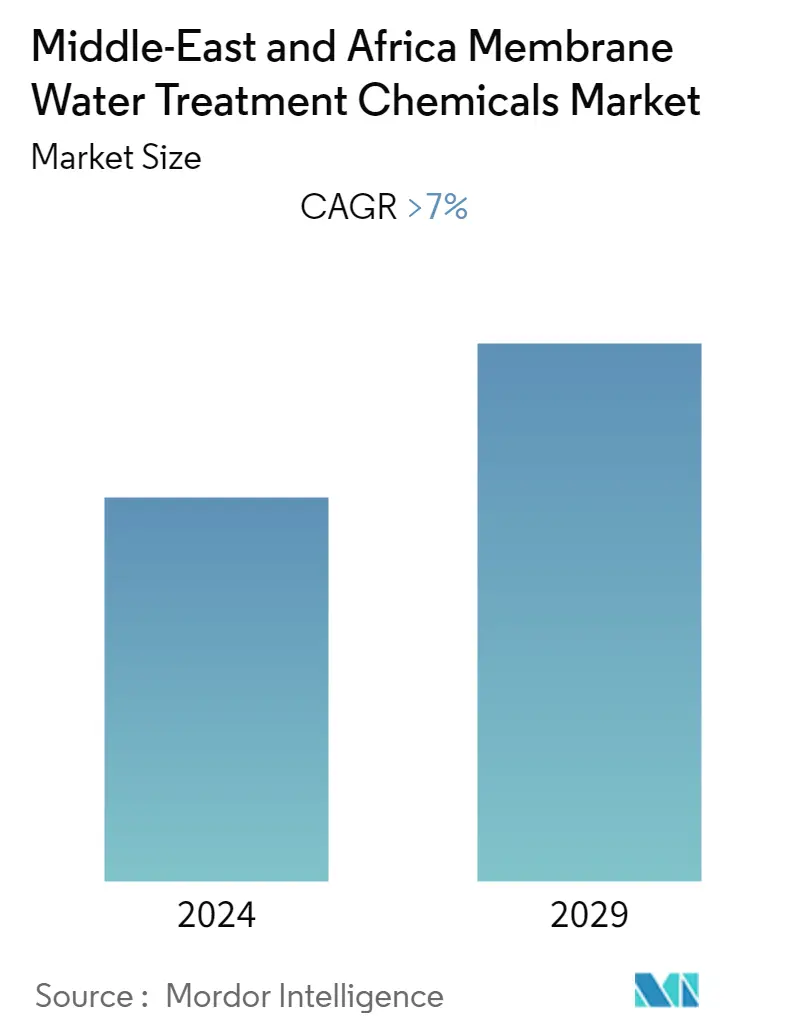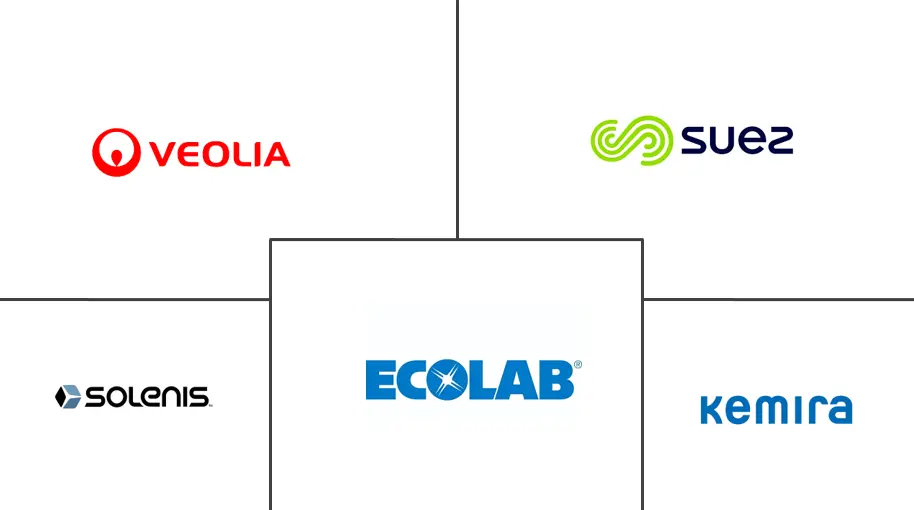Market Size of Middle-East and Africa Membrane Water Treatment Chemicals Industry

| Study Period | 2019 - 2029 |
| Base Year For Estimation | 2023 |
| Forecast Data Period | 2024 - 2029 |
| Historical Data Period | 2019 - 2022 |
| CAGR | 7.00 % |
| Market Concentration | Medium |
Major Players
*Disclaimer: Major Players sorted in no particular order |
Need a report that reflects how COVID-19 has impacted this market and its growth?
Middle-East and Africa Membrane Water Treatment Chemicals Market Analysis
The market for membrane water treatment chemicals market in Middle-East and Africa is expected to register a CAGR greater than 7% during the forecast period.
One of the major factors driving the market studied is the rising demand for freshwater. According to the UNICEF Organization in Middle East and North Africa (MENA), nearly nine out of ten children live in places with high or extremely high water stress, which has major effects on their health, nutrition, cognitive development, and future livelihoods. However, the high capital cost is restraining the demand for membrane water treatment chemicals in the Middle-East and African region.
Among the end-user industries, the desalination industry accounts for the largest market share, and it is expected to continue its dominance during the forecast period.
The growing usage of membrane bioreactors is expected to provide a major growth opportunity for the market studied.
The United Arab Emirates has accounted for the major share of the Middle-East and African market, and it is expected to continue its dominance during the forecast period.
Middle-East and Africa Membrane Water Treatment Chemicals Industry Segmentation
Membrane water treatment chemicals are barriers in water treatment that enable water to flow through but prevent undesired contaminants from doing so. The market is segmented by chemical type (pre-treatment, biological controllers, and other chemicals), end-user industry (food and beverage processing, desalination, healthcare, municipal, chemicals, power, and other end-user industries), and geography (Saudi Arabia, South Africa, Qatar, United Arab Emirates, Egypt, and Rest of Middle-East and Africa). The report offers the market size and forecasts in revenue (USD million) for all the above segments.
| Chemical Type | |
| Pre-treatment | |
| Biological Controllers | |
| Other Chemical Types |
| End-user Industry | |
| Food and Beverage Processing | |
| Desalination | |
| Healthcare | |
| Municipal | |
| Chemicals | |
| Power | |
| Other End-user Industries |
| Geography | |
| Saudi Arabia | |
| South Africa | |
| Qatar | |
| United Arab Emirates | |
| Egypt | |
| Rest of Middle-East and Africa |
Middle-East and Africa Membrane Water Treatment Chemicals Market Size Summary
The Middle-East and Africa membrane water treatment chemicals market is poised for significant growth, driven by the increasing demand for freshwater in a region characterized by severe water scarcity. The Middle-East and North Africa (MENA) region faces high water stress, impacting the health and development of its population, particularly children. This has led to a burgeoning need for effective water treatment solutions, with the desalination industry holding the largest market share. Despite the high capital costs associated with these technologies, the growing adoption of membrane bioreactors presents a promising opportunity for market expansion. The United Arab Emirates, a key player in the region, continues to lead the market, supported by its strategic initiatives aimed at ensuring long-term water security.
The region's arid climate and limited renewable water resources have intensified the focus on desalination processes to meet the rising water demand from its growing population and agricultural activities. The UAE's Water Security Strategy 2036 exemplifies the proactive measures being undertaken to enhance water sustainability and accessibility. The market landscape is moderately fragmented, with major players like Solenis, Ecolab, Kemira, Suez, and Toray contributing to the competitive environment. Recent strategic moves, such as Solenis's acquisition of Sigura Water, highlight the ongoing efforts to expand market presence and capabilities. These developments underscore the dynamic nature of the market, as stakeholders strive to address the critical water challenges facing the region.
Middle-East and Africa Membrane Water Treatment Chemicals Market Size - Table of Contents
-
1. MARKET DYNAMICS
-
1.1 Drivers
-
1.1.1 Growing Demand for Freshwater
-
1.1.2 Other Drivers
-
-
1.2 Restraints
-
1.2.1 High Capital Cost
-
1.2.2 Other Restraints
-
-
1.3 Industry Value Chain Analysis
-
1.4 Porter's Five Forces Analysis
-
1.4.1 Bargaining Power of Suppliers
-
1.4.2 Bargaining Power of Consumers
-
1.4.3 Threat of New Entrants
-
1.4.4 Threat of Substitute Products and Services
-
1.4.5 Degree of Competition
-
-
-
2. MARKET SEGMENTATION
-
2.1 Chemical Type
-
2.1.1 Pre-treatment
-
2.1.2 Biological Controllers
-
2.1.3 Other Chemical Types
-
-
2.2 End-user Industry
-
2.2.1 Food and Beverage Processing
-
2.2.2 Desalination
-
2.2.3 Healthcare
-
2.2.4 Municipal
-
2.2.5 Chemicals
-
2.2.6 Power
-
2.2.7 Other End-user Industries
-
-
2.3 Geography
-
2.3.1 Saudi Arabia
-
2.3.2 South Africa
-
2.3.3 Qatar
-
2.3.4 United Arab Emirates
-
2.3.5 Egypt
-
2.3.6 Rest of Middle-East and Africa
-
-
Middle-East and Africa Membrane Water Treatment Chemicals Market Size FAQs
What is the current Middle-East and Africa Membrane Water Treatment Chemicals Market size?
The Middle-East and Africa Membrane Water Treatment Chemicals Market is projected to register a CAGR of greater than 7% during the forecast period (2024-2029)
Who are the key players in Middle-East and Africa Membrane Water Treatment Chemicals Market?
Ecolab, Kemira, Suez, Veolia Water Solutions & Technologies and Solenis are the major companies operating in the Middle-East and Africa Membrane Water Treatment Chemicals Market.

